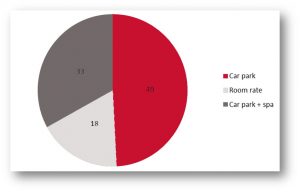In a previous blog I looked at the behaviours to use when responding to proposals in a negotiation, and emphasised the importance of linking negotiable issues together through Conditional proposals. In this blog I want to review the use of trading strategies revealed through some of the questions asked in our 2014 global negotiation survey.
A key point about trading is that, for negotiation success, effective negotiators know at any point in a negotiation the value of what they have given away and the value of what they are getting in return.
Negotiation success - are you trading effectively?
One question in our global survey was aimed at getting an understanding of how well people thought through the cost of trading versus the value to the other side. We gave respondents a scenario of a hotel seller, who has the best car parking facilities and spa in the town and who is trying to secure a deal with a customer for a large group booking where most of the guests will be travelling by car and want to use the spa. The customer is putting the seller under pressure to reduce the room rate to match the competition. The options we gave respondents were as follows: reduce the room rate; offer the car parking for free (which is normally charged for) or offer the car parking and a spa voucher for free.
The graph below shows that almost half the respondents voted for offering the car park for free, which we would agree with. The point about the car park is that it is what we would call a “lever”; something that costs the seller little to give away but is of high value to the other side. Reducing the room rate (the least popular issue) is also of high value to the other side, but is more costly to the seller.
What is most interesting is the 33% who would offer the car park and a spa voucher. On the face of it this would seem an attractive offer to the customer, but the key consideration here is the cost to the seller of what they are giving away. When we analysed the responses by job role we found that sellers were the least likely to go for the car park and spa option, and most likely to go for the car park alone, suggesting that of all the job roles they had the best understanding of the costs involved. Buyers also liked the car park option, but more of them went for the car park and spa than did the sellers. This was somewhat surprising, as we expected professional buyers to show a good understanding of the costs involved. Buyers may have made this choice because they were looking at the situation from a buy-side perspective, in which case the car park plus spa would be a more attractive option than the car park alone. If this is the case then the lesson for these buyers is to remember that understanding the other party’s point of view and interests is key to negotiation success.
Interestingly the job role that was most likely to go for the car park and spa and least likely to go for the car park alone was Customer Service. Perhaps Customer Service are accustomed to giving things away as part of their role without really understanding the costs involved, in which case this may be an important key training consideration for them.
To summarise the key message about trading is being aware of the cost of every move you make, compared to what the other side is giving you in return, and how much they value your concessions. Achieving win-win outcomes in negotiation is easier if you can offer to the other side moves that cost you little but are of high value and importance to them, and vice versa. This means being able to spot both your levers and the potential levers for the other side.








